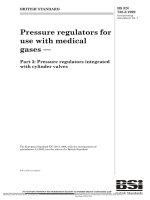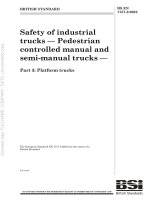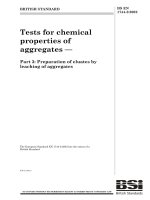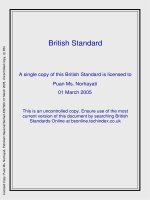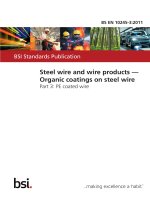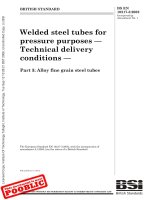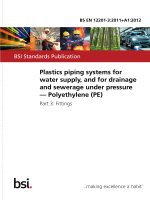Bsi bs en 12944 3 2002 (2011)
Bạn đang xem bản rút gọn của tài liệu. Xem và tải ngay bản đầy đủ của tài liệu tại đây (277.94 KB, 20 trang )
Confirmed
June 2011
NO COPYING WITHOUT BSI PERMISSION EXCEPT AS PERMITTED BY COPYRIGHT LAW
EN 12944-3
EUROPEAN STANDARD
NORME EUROPÉENNE
EUROPÄISCHE NORM
November 2001
ICS 01.040.65; 65.080
English version
Fertilizers and liming materials - Vocabulary - Part 3: Terms
relating to liming materials
Engrais et amendements calciques et/ou magnésiens Vocabulaire - Partie 3: Termes relatifs aux amendements
calciques et/ou magnésiens
Düngemittel und Calcium-/MagnesiumBodenverbesserungsmittel - Wörterbuch - Teil 3: Begriffe
für Calcium-/Magnesium-Bodenverbesserungsmittel
This European Standard was approved by CEN on 29 September 2001.
CEN members are bound to comply with the CEN/CENELEC Internal Regulations which stipulate the conditions for giving this European
Standard the status of a national standard without any alteration. Up-to-date lists and bibliographical references concerning such national
standards may be obtained on application to the Management Centre or to any CEN member.
This European Standard exists in three official versions (English, French, German). A version in any other language made by translation
under the responsibility of a CEN member into its own language and notified to the Management Centre has the same status as the official
versions.
CEN members are the national standards bodies of Austria, Belgium, Czech Republic, Denmark, Finland, France, Germany, Greece,
Iceland, Ireland, Italy, Luxembourg, Netherlands, Norway, Portugal, Spain, Sweden, Switzerland and United Kingdom.
EUROPEAN COMMITTEE FOR STANDARDIZATION
COMITÉ EUROPÉEN DE NORMALISATION
EUROPÄISCHES KOMITEE FÜR NORMUNG
Management Centre: rue de Stassart, 36
© 2001 CEN
All rights of exploitation in any form and by any means reserved
worldwide for CEN national Members.
B-1050 Brussels
Ref. No. EN 12944-3:2001 E
EN 12944-3:2001 (E)
Foreword
This European Standard has been prepared by CEN/TC 260 "Fertilizers and liming materials", the secretariat of
which is held by DIN.
This European Standard shall be given the status of a national standard, either by publication of an identical text or
by endorsement, at the latest by May 2002, and conflicting national standards shall be withdrawn at the latest by
May 2002.
This European standard is in three parts:
Part 1: General terms.
Part 2: Terms relating to fertilizers.
Part 3: Terms relating to liming materials.
These definitions may not necessarily correspond with those used in national legislation.
NOTE
A classification scheme for fertilizers and liming materials is given in EN 13535.
The annexes A and B are informative.
According to the CEN/CENELEC Internal Regulations, the national standards organizations of the following
countries are bound to implement this European Standard: Austria, Belgium, Czech Republic, Denmark, Finland,
France, Germany, Greece, Iceland, Ireland, Italy, Luxembourg, Netherlands, Norway, Portugal, Spain, Sweden,
Switzerland and the United Kingdom.
2
EN 12944-3:2001 (E)
1
Scope
This European Standard defines terms relating to liming materials.
An index of all terms defined in this part of EN 12944, with their French and German equivalents, is given in annex
A.
A general index of all terms defined in all three parts of EN 12944, with their French and German equivalents, is
given in annex B.
2
Terms and definitions
2.1
Terms relating to products or production
2.1.1
calcination
burning or heating of a material, usually in order to remove volatile components or in order to change the crystal
structure
2.1.2
carbonation
conversion of slaked lime to carbonate by uptake of carbon dioxide
2.1.3
chalk
form of calcium carbonate derived from the skeletons of microscopic marine organisms
2.1.4
wet grinding
grinding of material in the presence of water
2.1.5
degree of burning
degree to which carbon dioxide has been removed during the production of quicklime or burnt dolomite
2.1.6
lime-burnt dolomite
dolomitic limestone calcined to the same carbon dioxide level as normally burnt limestone
2.1.7
burnt dolomite
liming material mainly consisting of calcium oxide and magnesium oxide obtained by calcination of dolomitic
limestone
2.1.8
burnt magnesium lime
liming material mainly consisting of calcium oxide and magnesium oxide obtained by calcination of magnesian
limestone
2.1.9
free lime
<relating to products and production> the calcium oxides and/or hydroxides which have not reacted with the liming
material they are included in
NOTE
A definition of free lime relating to soils is given in 2.4.4.
3
EN 12944-3:2001 (E)
2.1.10
kiln
general term for the equipment used for lime burning
2.1.11
rotary kiln
rotary tubular counter-current kiln
2.1.12
shaft kiln
kiln constructed as a vertical combustion shaft
2.1.13
lime
general term for burnt lime and hydrated lime
2.1.14
burnt lime
quick lime
liming material consisting mainly of calcium oxide, or a mixture of calcium oxide and possibly magnesium oxide,
produced by the calcination of limestone, magnesian limestone or dolomitic limestone
2.1.15
filter lime
liming material in the form of dust, obtained from flue gases during lime burning
2.1.16
slaked lime
hydrated lime
liming material consisting mainly of calcium hydroxide, or a mixture of calcium hydroxide and possibly magnesium
hydroxide, produced by a controlled reaction between burnt lime and water
NOTE
The reaction between burnt lime and water is referred to as "slaking".
2.1.17
limestone
natural rock consisting mainly of varying amounts of calcium carbonate and magnesium carbonate, containing less
than a mass fraction of 2 % of magnesium expressed as Mg
2.1.18
magnesian limestone
natural rock consisting mainly of varying amounts of calcium carbonate and magnesium carbonate, containing a
mass fraction of at least 2 % and less than 10 % of magnesium expressed as Mg
2.1.19
dolomitic limestone
natural rock consisting mainly of varying amounts of calcium carbonate and magnesium carbonate, containing a
mass fraction of at least 10 % of magnesium expressed as Mg
2.1.20
liming material
agricultural lime
inorganic material containing one or both of the elements calcium and magnesium, mainly in the form of oxide,
hydroxide, carbonate, or silicate, principally intended to maintain or raise the pH in soil and water and to improve
plant nutrition and to modify physical properties of soil
NOTE 1
The term “lime” is also used but "liming material" or “agricultural lime” are preferred.
NOTE 2
In France, the expression "amendement minéral basique" is now preferred to "amendement calcique et/ou
magnésien" (liming product) when referring to of a product having an effect on the pH of the soil.
4
EN 12944-3:2001 (E)
2.1.21
silicate liming material
basic slag from metallurgical processes such as blast furnaces or converters
2.1.22
blast furnace lime
blast furnace slag
product from ironmaking consisting mainly of calcium silicates and magnesium silicates
2.1.23
converter lime
converter slag
product from steelmaking consisting mainly of calcium silicates
2.1.24
sludge liming material
product from industry consisting of calcium carbonate and/or calcium hydroxide and a substantial amount of water
2.1.25
sugar factory lime
product from the sugar industry obtained by carbonation and containing calcium carbonate
2.1.26
marl
soft natural deposit containing varying amounts of calcium carbonate mixed with clay
2.1.27
carbonate rock
natural rock with a carbonate mineral as its main constituent
NOTE
Limestone, chalk, dolomitic limestone and magnesite are examples of carbonate rocks.
2.1.28
calcite
trigonal crystalline form of calcium carbonate
2.1.29
aragonite
orthorhombic crystalline form of calcium carbonate
2.1.30
magnesite
crystalline mineral with the chemical composition magnesium carbonate isomorphic with calcite
2.1.31
slag
general term for a liming material from metallurgical processes consisting mainly of calcium silicates and
magnesium silicates
2.1.32
dry slaking
slaking of burnt lime with least possible amount of water resulting in a powdery slaked lime
2.1.33
wet slaking
slaking of burnt lime with surplus water resulting in slaked lime in the form of milk-of-lime, slurry or paste
5
EN 12944-3:2001 (E)
2.1.34
liming material of natural origin
calcium or calcium and magnesium carbonates, oxides and hydroxides produced from naturally occuring geological
deposits
2.2
Terms relating to physical or physico-chemical properties
2.2.1
acid insoluble residue
matter remaining after the liming material has been dissolved in hydrochloric acid (HCl)
NOTE
For the English term "acid insoluble residue" AIR is commonly used as an abbreviation.
2.2.2
alkaline solution
basic solution
solution with a pH higher than 7
2.2.3
alkalinity
capacity to neutralize acids, i.e. absorbing hydrogen ions
2.2.4
acid solution
solution with a pH lower than 7
2.2.5
acidification
natural or imposed process resulting in lower pH values in soils, watercourses and lakes
2.2.6
buffer capacity
capacity to resist a change in pH value when acid or alkali is added
2.2.7
basicity
ratio between alkaline oxides and acidic oxides
2.2.8
neutralization
+
reaction when a surplus of H or OH is eliminated through addition of alkali or acid respectively
NOTE
+
Liming materials are used to eliminate surplus of H .
2.2.9
carbon dioxide residue
residual carbonate content measured as carbon dioxide (CO2) in burnt lime
2.2.10
loss on ignition
mass loss by heating a dried sample to constant mass at a specified temperature
NOTE
For the English term "loss on ignition" LOI is commonly used as an abbreviation.
2.2.11
neutralizing effect
ability of a liming material to neutralize soil acidity or water acidity
6
EN 12944-3:2001 (E)
2.2.12
pH value
10-logarithm for the inverted value of the hydrogen ion activity in a solution
2.2.13
neutralizing value
NV
number which represents the amount in kilograms of calcium oxide (CaO) which has the same neutralizing effect
as 100 kg of the product under consideration
2.2.14
reactivity
rate of reaction of a liming material with acid under specified conditions
2.2.15
specific area
particle surface area per volume of a mineral product including possible internal pores
2.3
Terms relating to agricultural and environmental liming purposes and use
2.3.1
liming for preservation purposes
periodic liming of soils or water to correct and maintain the pH value appropriate for the habitat in question
2.3.2
liming for rehabilitation purposes
liming of soils or water in one or several steps to increase the pH value to a level appropriate for the habitat in
question
2.3.3
liming for soil protection purposes
liming of arable grass land or forest soils to limit erosion and maintain the soil pH at a level which inhibits the
availability of harmful minor elements
2.4
Terms relating to liming effect
2.4.1
lime requirement
amount of liming material required to replace the loss of lime in the soil or in the water occurring in the habitat, or
needed to reach a defined level
2.4.2
liming effect
effect of a liming material on soil physical properties and pH increase
2.4.3
total liming effect
theoretical maximum acid neutralizing capacity when a liming material has stopped reacting in the soil or in the
water
2.4.4
free lime
soil excess liming material
<relating to soil> calcium or magnesium carbonates and/or hydroxides which have not reacted with any soil
particles
NOTE
A definition of free lime relating to products or production is given in 2.1.9.
7
8
calcination
calcite
carbon dioxide residue
carbonate rock
carbonation
chalk
converter lime
converter slag
C
basic solution
basicity
blast furnace lime
blast furnace slag
buffer capacity
burnt dolomite
burnt lime
burnt magnesium lime
B
acid insoluble residue
acid solution
acidification
agricultural lime
alkaline solution
alkalinity
aragonite
A
(E)
EN 12944-3:2001 (E)
calcination
calcite
teneur résiduelle en CO2
roche carbonatée
carbonatation
craie
chaux de convertisseur
scorie de convertisseur
solution basique
basicité
laitier de hauts-fourneaux
scorie de hauts-fourneaux
pouvoir tampon
dolomie calcinée
chaux vive
chaux vive magnésienne
insoluble chlorhydrique
solution acide
acidification
amendement minéral basique
solution alcaline
alcalinité
aragonite
(F)
Index
Annex A
(informative)
Calcinierung
Calcit
Kohlenstoffdioxidrückstand
Carbonatgestein
Carbonatisierung
Kreide
Konverterkalk
Konverterschlacke
basische Lösung
Basizität
Hüttenkalk
Hochofenschlacke
Puffervermögen
gebrannter Dolomit
gebrannter Kalk, Branntkalk
gebrannter Magnesiumkalk
säureunlöslicher Rückstand
saure Lösung
Versauerung
Kalkdünger (für die Landwirtschaft)
alkalische Lösung
Alkalität
Aragonit
(D)
2.1.1
2.1.28
2.2.9
2.1.27
2.1.2
2.1.3
2.1.23
2.1.23
2.2.2
2.2.7
2.1.22
2.1.22
2.2.6
2.1.7
2.1.14
2.1.8
2.2.1
2.2.4
2.2.5
2.1.20
2.2.2
2.2.3
2.1.29
liming material of natural origin
loss on ignition
liming material
liming for soil protection purposes
liming for rehabilitation purposes
lime
lime-burnt dolomite
lime requirement
limestone
liming effect
liming for preservation purposes
L
kiln
K
hydrated lime
H
filter lime
free lime
<relating to products and production>
free lime
<relating to soil>
F
degree of burning
dolomitic limestone
dry slaking
D
(E)
amendement minéral basique d'origine naturelle
perte au feu
chaux
chaux dolomitique
besoin en chaux
calcaire
effet chaulage
amendements minéraux basiques
effectués à des fins d'entretien
amendements minéraux basiques
effectués à des fins de redressement
amendements minéraux basiques
effectués pour protéger les sols
amendement minéral basique
four à chaux
chaux hydratée
poussière d'electrofiltre
chaux libre
<relatifs aux produits ou à la production>
chaux libre
<relatif au soil>
degré de cuisson
calcaire dolomitique
extinction à sec
(F)
2.1.5
2.1.19
2.1.32
2.3.1
2.3.2
2.3.3
Erhaltungskalkung
Sanierungskalkung
Bodenschutzkalkung
Calcium-/MagnesiumBodenverbesserungsmittel
Naturkalk
Abbrandverlust
2.1.20
2.1.34
2.2.10
2.1.13
2.1.6
2.4.1
2.1.17
2.4.2
2.1.10
2.1.16
Kalk
kalkgebrannter Dolomit
Kalkbedarf
Kalkstein
Wirkung der Kalkung
Brennofen
hydrierter Kalk
Filterkalk
2.1.15
freier Kalk
<bezogen auf Produkte und Produktion> 2.1.9
freier Kalk
<bezogen auf Boden>
2.4.4
Brenngrad
dolomitischer Kalkstein
trockenes Löschen
(D)
9
EN 12944-3:2001 (E)
10
wet grinding
wet slaking
W
total liming effect
T
shaft kiln
silicate liming material
slag
slaked lime
sludge liming material
soil excess liming material
specific area
sugar factory lime
S
reactivity
rotary kiln
R
quick lime
Q
pH value
P
neutralization
neutralizing effect
neutralizing value
N
magnesian limestone
magnesite
marl
M
(E)
EN 12944-3:2001 (E)
broyage humide
extinction humide
effet de chaulage total
four à chaux vertical
amendements basiques sidérurgiques
scorie
chaux éteinte
boues alcalinisantes
amendements calciques et/ou magnésiens excédentaires
surface spécifique
écume de sucrerie
réactivité
four à chaux rotatif
chaux vive
valeur pH
neutralisation
effet de neutralisation
valeur de neutralisation
calcaire magnésien
magnésite
marne
(F)
Nassmahlen
feuchtes Löschen
Gesamtwirkung der Kalkung
Schachtofen
Kalk aus Eisenhüttenschlacke
Schlacke
Löschkalk
Kalkschlamm
überkalkter Boden
spezifische Fläche
Carbonatisierungskalk (Carbokalk)
Reaktivität
Drehrohrofen
Ätzkalk
pH-Wert
Neutralisation
Neutralisationswirkung
Neutralisationswert
magnesiumhaltiger Kalkstein
Magnesit
Mergel
(D)
2.1.4
2.1.33
2.4.3
2.1.12
2.1.21
2.1.31
2.1.16
2.1.24
2.4.4
2.2.15
2.1.25
2.2.14
2.1.11
2.1.14
2.2.12
2.2.8
2.2.11
2.2.13
2.1.18
2.1.30
2.1.26
basic slag
basic solution
basicity
big bag
blast furnace lime
blast furnace slag
blended fertilizer
bone meal
buffer capacity
bulk
bulk blend
bulk density (loose)
B
acid insoluble residue
acid solution
acidification
additive
agricultural lime
alkaline solution
alkalinity
anti-caking agent
apparent density
application
application rate
aragonite
availability
A
(E)
scories Thomas
solution basique
basicité
sac de grande taille
laitier de hauts-fourneaux
scorie de hauts-fourneaux
engrais de mélange
farine d´os
pouvoir tampon
vrac(en)
mélange en vrac
masse volumique sans tassement
insoluble chlorhydrique
solution acide
acidification
additif
amendement minéral basique
solution alcaline
alcalinité
anti-massant
masse volumique apparente
application
dose d'application
aragonite
assimilabilité, disponibilité
(F)
General index
Annex B
(informative)
Roheisenschlacke
basische Lưsung
Basizität
Grpackung, Big Bag
Hüttenkalk
Hochofenschlacke
Mischdünger
Knochenmehl
Puffervermưgen
lose Schüttung
lose Mischung
Schüttdichte
säureunlưslicher Rückstand
saure Lưsung
Versauerung
Additiv
Kalkdünger (für die Landwirtschaft)
alkalische Lösung
Alkalität
Antibackmittel
scheinbare Dichte
Anwendung, Applikation
Aufwandmenge
Aragonit
Verfügbarkeit
(D)
2.1.1
2.2.2
2.2.7
2.43
2.1.22
2.1.22
2.13
2.1.3
2.2.6
2.44
2.14
2.2.2
2.2.1
2.2.4
2.2.5
2.41
2.1.20
2.2.2
2.2.3
2.2.10
2.2.1
2.18
2.19
2.1.29
2.45
Reference
2
3
3
1
3
3
1
2
3
1
1
2
3
3
3
1
3
3
3
2
2
1
1
3
1
Part
11
EN 12944-3:2001 (E)
12
fertilization
fertilizer
fertilizer unit
filler
filter lime
fish compost
fish meal
flow rate
F
declarable content
declaration
degree of burning
dolomitic limestone
dried blood
dry slaking
dung
D
caking
calcination
calcite
carbon dioxide residue
carbonate rock
carbonation
chalk
chelated fertilizer
coated fertilizer
complex fertilizer
compound fertilizer
converter lime
converter slag
crushing strength
fertilisation
engrais
unité fertilisante
charge
poussière d'électrofiltre
compost de poisson
farine de poisson
taux d'écoulement
teneur déclarable
décIaration
degré de cuisson
calcaire dolomitique
farine de sang
extinction à sec
excréments
prise en masse
calcination
calcite
teneur résiduelle en CO2
roche carbonatée
carbonatation
craie
engrais chélaté
engrais enrobé
engrais complexe
engrais composé
chaux de convertisseur
scorie de convertisseur
résistance à I'écrasement
masse volumique après tassement
dolomie calcinée
chaux vive
chaux vive magnésienne
bulk density (tapped)
burnt dolomite
burnt lime
burnt magnesium lime
C
(F)
(E)
EN 12944-3:2001 (E)
Düngung
Düngemittel
Düngereinheit
Füllstoff
Filterkalk
Fischkompost
Fischmehl
Fließrate, Fließkennzahl
deklarierbarer Gehalt
Deklaration
Brenngrad
dolomitischer Kalkstein
Trockenblut
trockenes Löschen
Dung
Verbacken
Calcinierung
Calcit
Kohlenstoffdioxidrückstand
Carbonatgestein
Carbonatisierung
Kreide
chelatisiertes Düngemittel
umhülltes Düngemittel
Komplexdünger
Mehrnährstoffdünger
Konverterkalk
Konverterschlacke
Kornfestigkeit
Rütteldichte
gebrannter Dolomit
gebrannter Kalk, Branntkalk
gebrannter Magnesiumkalk
(D)
2.17
2.1
2.26
2.42
2.1.15
2.1.5
2.1.6
2.2.15
2.28
2.29
2.1.5
2.1.19
2.1.2
2.1.32
2.1.4
2.2.9
2.1.1
2.1.28
2.2.9
2.1.27
2.1.2
2.1.3
2.3
2.32
2.12
2.11
2.1.23
2.1.23
2.2.8
2.2.3
2.1.7
2.1.14
2.1.8
Reference
1
1
1
1
3
2
2
2
1
1
3
3
2
3
2
2
3
3
3
3
3
3
1
1
1
1
3
3
2
2
3
3
3
Part
liming for rehabilitation purposes
leather waste
lime
lime-burnt dolomite
lime requirement
limestone
liming effect
liming for preservation purposes
L
kiln
K
inhibitor
inorganic fertilizer
intermediate
I
hydrated lime
H
gel strength
granular fertilizer
granulation
guano
guarantee (of composition)
déchet de cuir
chaux
chaux dolomitique
besoin en chaux
calcaire
effet chaulage
amendements minéraux basiques
effectués à des fins d'entretien
amendements minéraux basiques
effectués à des fins de redressement
four à chaux
inhibiteur
engrais minéral [inorganique]
intermédiaire
chaux hydratée
résistance d'un gel
engrais en granulés
granulation
guano
garantie (de composition)
engrais fluide
engrais foliaire
formule
écoulement libre
chaux libre
<relatifs aux produits ou à la production>
chaux libre
<relatif au soil>
fluid fertilizer
foliar fertilizer
formula
free flowing
free lime
<relating to products and production>
free lime
<relating to soil>
G
(F)
(E)
3
2.4.4
2.1.8
2.1.13
2.1.6
2.4.1
2.1.17
2.4.2
2.3.1
2.3.2
Erhaltungskalkung
Sanierungskalkung
2.1.10
2.46
2.2
2.47
2.1.16
3
3
2
3
3
3
3
3
3
1
1
1
3
2
1
1
2
1
3
2.1.9
2.2.12
2.33
2.34
2.1.7
2.30
1
1
1
2
Part
2.38
2.15
2.27
2.2.16
Reference
Lederabfall
Kalk
kalkgebrannter Dolomit
Kalkbedarf
Kalkstein
Wirkung der Kalkung
Brennofen
Hemmstoff
mineralisches Düngemittel
Zwischenprodukt
hydrierter Kalk
Gelfestigkeit
gekörntes [granuliertes] Düngemittel
Granulierung
Guano
Garantie (der Zusammensetzung)
Flüssigdünger
Blattdünger
Formel
frei fließend
freier Kalk
<bezogen auf Produkte und Produktion>
freier Kalk
<bezogen auf Boden>
(D)
13
EN 12944-3:2001 (E)
amendement minéral basique d'origine naturelle
déchets liquides d'abattoir
perte au feu
liming material of natural origin
liquid manure
loss on ignition
14
particle size
particle size analysis
[granulometry] by sieving
peat
pelletized fertilizer
P
oil cake
organic fertilizer
organic nitrogenous fertilizer
organo-mineral fertilizer
oversize
O
neutralization
neutralizing effect
neutralizing value
nitrophosphate fertilizer
non-nutrient element
N
magnesian limestone
magnesite
manure
marl
meat meal
methylene urea
micro-nutrient
mineralization
moisture
M
Korngrưße
Korngrưßenanalyse durch Siebung
Torf
pelletiertes Düngemittel
tourbe
engrais en bouchons
Ưlkuchen
organisches Düngemittel
organischer Stickstoffdünger
organisch-mineralisches Düngemittel
Überkorn
Neutralisation
Neutralisationswirkung
Neutralisationswert
Nitrophosphatdünger
nicht-essentielles Element
magnesiumhaltiger Kalkstein
Magnesit
Stallmist
Mergel
Fleischmehl
Harnstoffkondensat
Spurennährstoff
Mineralisation
Feuchte
Bodenschutzkalkung
Calcium-/MagnesiumBodenverbesserungsmittel
Naturkalk
Jauche
Abbrandverlust
(D)
taille des particules
analyse granulométrique par tamisage
tourteau d'oléagineux
engrais organique
engrais organique azoté
engrais organo-minéral
refus
neutralisation
effet de neutralisation
valeur de neutralisation
engrais nitrophosphaté
élément non nutritif
calcaire magnésien
magnésite
furnier
marne
farine de viande
urée condensée
oligo-élément
minéralisation
humidité
amendements minéraux basiques
effectués pour protéger les sols
amendement minéral basique
liming for soil protection purposes
liming material
(F)
(E)
EN 12944-3:2001 (E)
2.1.14
2.37
2.35
2.2.4
2.1.13
2.4
2.5
2.7
2.2.7
2.2.8
2.2.11
2.2.13
2.49
2.24
2
1
1
2
2
1
1
1
2
3
3
3
1
1
3
3
2
3
2
2
1
1
2
3
3
2
3
2.1.20
2.1.34
2.1.9
2.2.10
2.1.18
2.1.30
2.1.10
2.1.26
2.1.11
2.1.12
2.23
2.48
2.2.19
3
Part
2.3.3
Reference
saturation temperature
secondary nutrient
sedimentation
segregation
shaft kiln
sieving
silicate liming material
slag
slaked lime
slow-release fertilizer
sludge liming material
slurry
soil excess liming material
soil fertility
soil improver
solubility of a fertilizer nutrient
solution fertilizer
specific area
sphericity
straight fertilizer
sugar factory lime
suspension fertilizer
S
reactivity
rotary klin
R
quick lime
température de saturation
élément secondaire
sédimentation
ségrégation
four à chaux vertical
tamisage
amendements basiques sidérurgiques
scorie
chaux éteinte
engrais à libération lente
boues alcalinisantes
lisier
amendements calciques et/ou magnésiens excédentaires
fertilité d'un sol
amendement d'un sol
solubilité d'un élément fertilisant
engrais en solution
surface spécifique
sphéricité
engrais simple
écume de sucrerie
engrais en suspension
réactivité
four à chaux rotatif
chaux vive
valeur pH
élément nutritif
rapport en élément nutritif
porosité
aptitude à I'écoulement
engrais prillé
élément majeur
pH value
plant nutrient
plant nutrient ratio
porosity
pourability
prilled fertilizer
primary nutrient
Q
(F)
(E)
Sättigungstemperatur
Sekundärnährstoff
Sedimentation
Segregation
Schachtofen
Siebung
Kalk aus Eisenhüttenschlacke
Schlacke
Löschkalk
langsam freisetzendes Düngemittel
Kalkschlamm
Gülle, Flüssigmist
überkalkter Boden
Bodenfruchtbarkeit
Bodenverbesserungsmittel
Lưslichkeit eines Düngernährstoffs
Düngerlưsung
spezifische Fläche
Rundheit
Einnährstoffdünger
Carbonatisierungskalk (Carbokalk)
Düngersuspension
Reaktivität
Drehrohrofen
Ätzkalk
pH-Wert
Pflanzennährstoff
Nährstoff [NPK]-Verhältnis
Porosität
Gibarkeit
geprilltes Düngemittel
Primärnährstoff
(D)
2.2.11
2.22
2.2.14
2.2.17
2.1.12
2.2.5
2.1.21
2.1.31
2.1.16
2.8
2.1.24
2.1.15
2.4.4
2.16
2.9
2.25
2.39
2.2.15
2.2.18
2.10
2.1.25
2.40
2.2.14
2.1.11
2.1.14
2.2.12
2.20
2.31
2.2.20
2.2.13
2.36
2.21
Reference
2
1
2
2
3
2
3
3
3
1
3
2
3
1
1
1
1
3
2
1
3
1
3
3
3
3
1
1
2
2
1
1
Part
15
EN 12944-3:2001 (E)
16
wet grinding
wet slaking
W
undersize
urea condensate
urea formaldehyde
U
total liming effect
broyage humide
extinction humide
tamisat-passant
urée condensée
urée formaldéhyde
effet de chaulage total
engrais azoté de synthèse organique
synthetic organic nitrogenous fertilizer
T
(F)
(E)
EN 12944-3:2001 (E)
Nassmahlen
feuchtes Löschen
Unterkorn
Harnstoffkondensat
Formaldehydharnstoff
Gesamtwirkung der Kalkung
synthetischer organischer
Stickstoffdünger
(D)
2.1.4
2.1.33
2.2.6
2.1.16
2.1.12
2.4.3
2.6
Reference
3
3
2
2
2
3
1
Part
EN 12944-3:2001 (E)
Bibliography
EN 13535, Fertilizers and liming materials —Classification.
17

